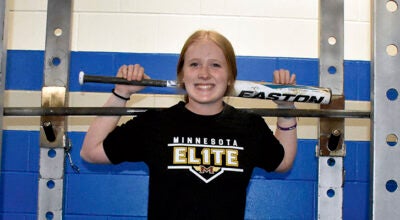Riege: Searching for fall Walleyes
Published 5:45 pm Wednesday, September 4, 2013
By Bob and Ginny Riege
Some of the finest walleye fishing of the year takes place during the fall. The trick is to find the best action, and to match your presentation to the mood of the fish.
Fall walleye fishing can be extremely unpredictable, but most sources will say that usually the poorest weather conditions will produce the largest fish. Most large fish caught in the fall are females. To nourish their developing eggs the female walleye needs to consume large quantities of food.
Now lets narrow down some areas that we can start to concentrate on. First of all, these big females have to eat, right? They will move shallow in a lake or river to feed and usually they need some reason to do so. The reason is that is where the prey fish have moved. Lakes have a tendency to layer out or “stratify.” In the fall this would mean that the depths of a lake are warmer than the shallows. The fall cycle of a lake allows the stratified layers to turnover and therefore the cooler water is on the shoreline.
Big walleyes will swim into the shallow waters to go on a feeding spree. If you are in the shallows when this takes place hang onto the rod, you are about to catch some of the largest walleyes of your life. As they get full they may slide down to deeper parts of the lake, but again remember they have to eat and one of the places to start looking for big walleyes is shallow. How shallow? Sometimes it maybe six inches of water, just enough to cover them.
Weather conditions often determine walleye location, dictate presentation, and ultimately measure success, yet weather is probably one of the least understood element of the fishing equation.
When either the weather or water changes rapidly, a fish must have a period of time to adjust to that change, and when they are adjusting they are not in the mood to become active; their body doesn’t allow it. That’s when some of the toughest fishing occurs.
Specific weather conditions tend to trigger a walleye feeding frenzy. Basically it’s a cold front, but there’s more to it than that. The ideal conditions for catching big walleyes may come only a half-dozen times in a season. To make the most of them a fisherman must watch forecasts and the clouds and be prepared to fish one step ahead of the storm.
The main concern dealing with the movement of fish is a cold front. The frequency of cold fronts vary in different parts of the country and at different times of the year. Regardless of the weather patterns in your part of the country, the cold front will have a profound effect on your fishing results.
The one element that harms the fish the most is light. That’s why the passing of a cold front is synonymous with poor fishing. We get an intense light condition, a bright blue sky, which will drive the fish to great depths. At these depths the fish will become very dormant and inactive.
A fish has no eyelids to block out the light. Rather than fight a bright light condition in shallow water, it will drop to a lower level seeking a darker environment.
This is not to say you can’t catch fish under bright conditions. Deep water interpretation of structure and knowing where to fish deep, plus knowing how to present lures at the proper depth and speed can help offset these bad effects.
Crankbaits are a great way to find those walleyes in cold front conditions because you can cover a lot of territory and concentrate on walleyes that are active. You may catch more walleyes on live bait rigs, but you’ll catch a bigger average size on crankbaits. In addition, crankbaits offer a rapid way to eliminate unproductive water. Plus, you can use the crankbait as a locator bait and then finesse them with live bait.
Two basic types of crankbaits can be used for the majority of your shallow-water walleye fishing. One is the long, thin floater diver like the Original Rapala. These have a lazy, side to side action that’s attractive to walleyes. The other type is the standard, bass style crankbait. But when you choose this style, use the smaller thin crankbaits in cold front conditions. The larger models don’t produce as well for walleyes. Select the smallest models that have deep-diving lips. Lures like a Shad Rap are excellent for this type of fishing. In general, use bright, visible colors like fluorescent orange or chartreuse in darker water, and subtle colors like silver, blue or black when the water is clear.
In the fall big fish like big baits. In fact, that is never truer than prior to ice-up. The water is cooling down rapidly and those fish won’t expend a great deal of energy on a snack. They want something substantial.
If the water is cooling off, the fish are slowing down. They become sluggish and don’t want to chase all over the lake for food. They want something easy and a lot of it. The anglers must also slow down their presentation to match the mood of the fish. Walleyes can’t resist the slow wobble of a Rattlin’ Fat Rap, or the wide sweep of the Jointed Rapala. These large fat baits pulled slowly on long-line trolling techniques or cast into the shallows produce fish.
Don’t overlook a plump nightcrawler or a jumbo leech pulled behind a Lindy Hatchet Spinner. Just because the bait is big and plump doesn’t mean that your hooks have to be gigantic either. A small hook allows a walleye to swallow the bait without feeling anything unusual. And a small hook will not break or pull out. Most big walleyes are hooked under snag-free conditions, so if you take your time and do not attempt to horse the fish, light line will do the job. Many times I will scale down my line from Original Stren 6 lb. test to a Stren Easy Cast 4 lb. test, just to get a better feel and allow the big walleye as little resistance as possible.
Think about what time of day you would like to be on the water. Most of us would like to be there when the weather is nice, sunny and bright. The big walleyes don’t want to be around during high sunny skies. They would prefer the low-light conditions or even the darkest night conditions to make their feeding run.
Monster walleyes are on most large bodies of water in the Upper Midwest. As the fall winds start to blow and you feel that you would rather be back at home sitting by the fire that is the time when monster walleyes are on the prowl. Try these simple techniques and you will see the monsters that swim in your lake or river.




